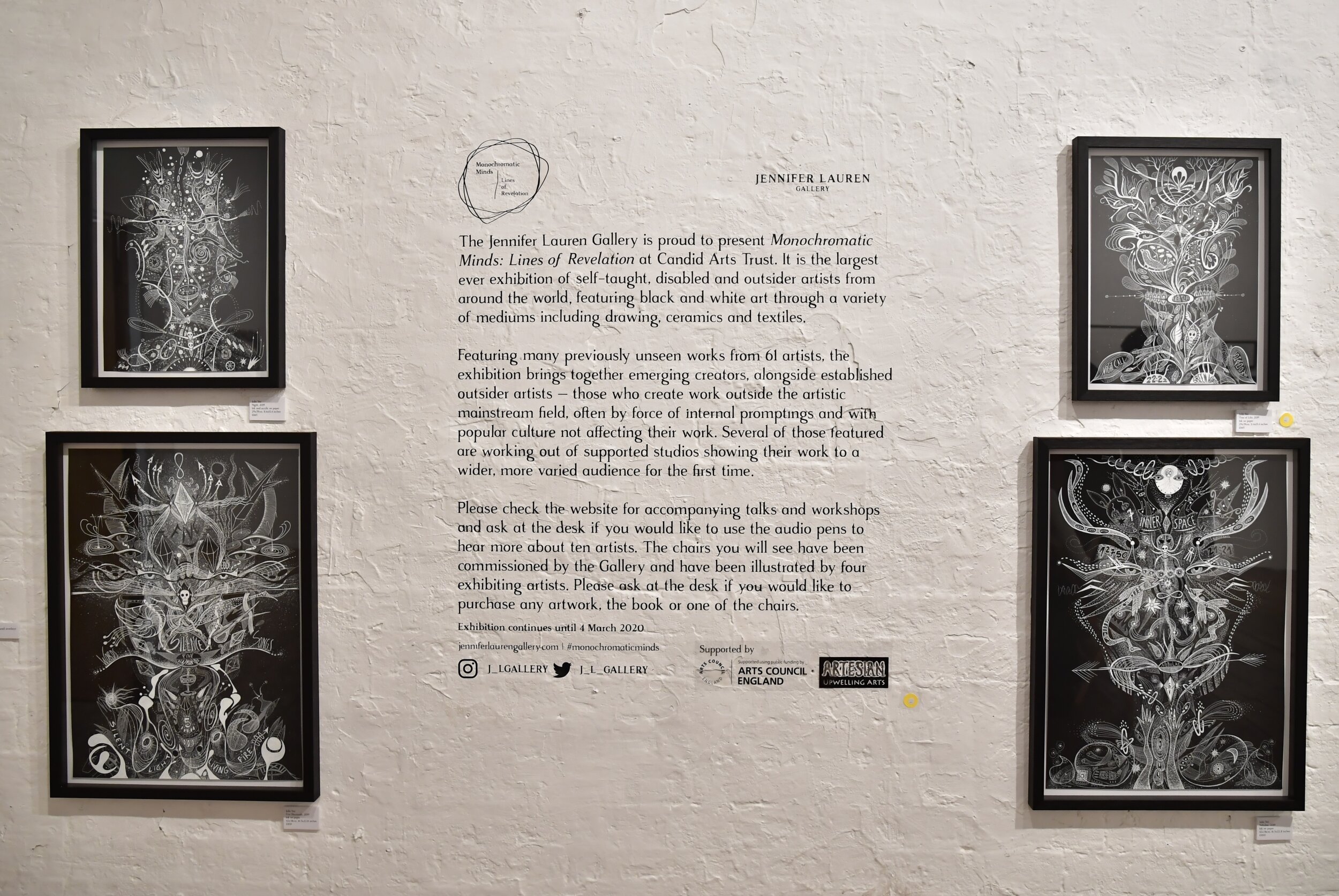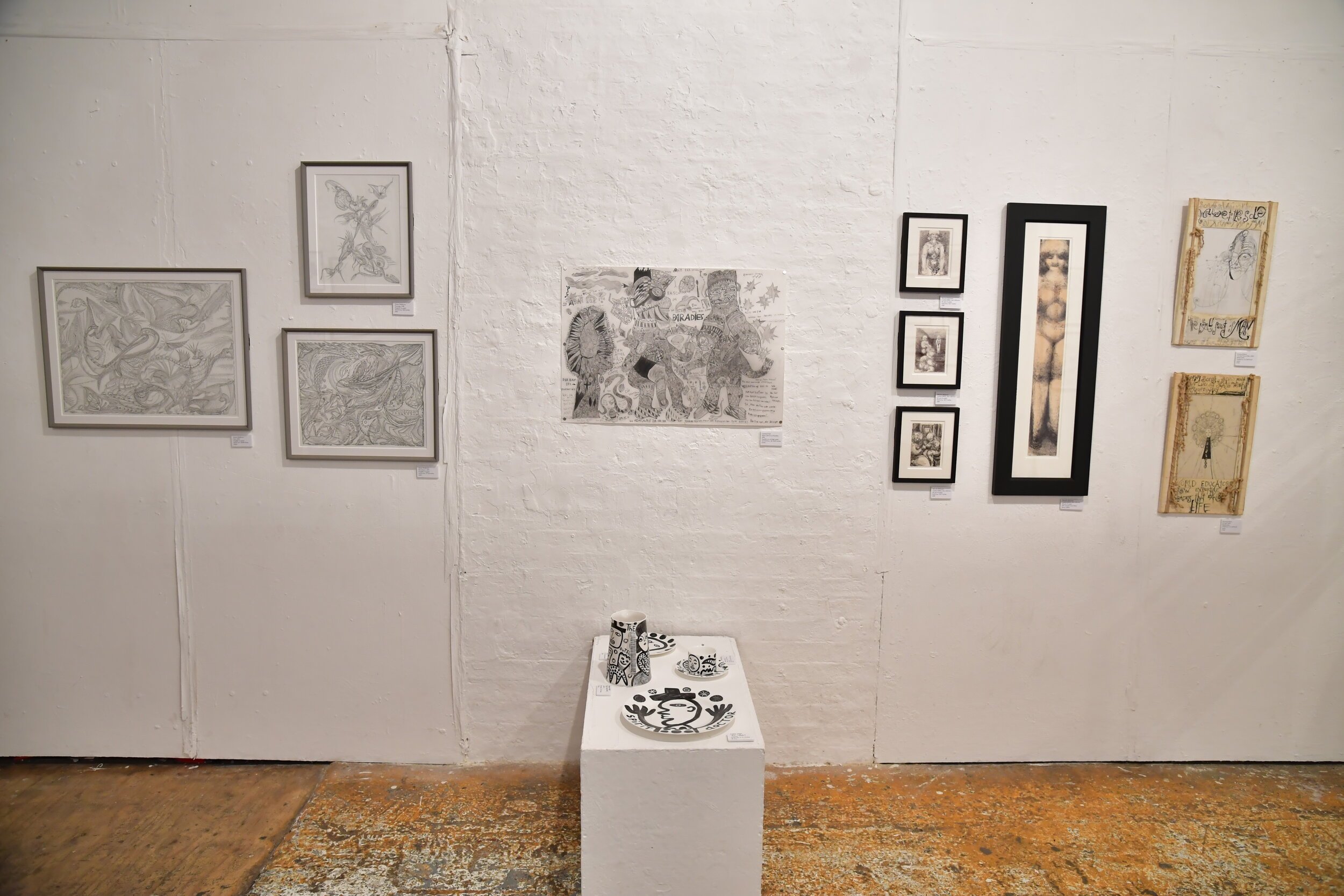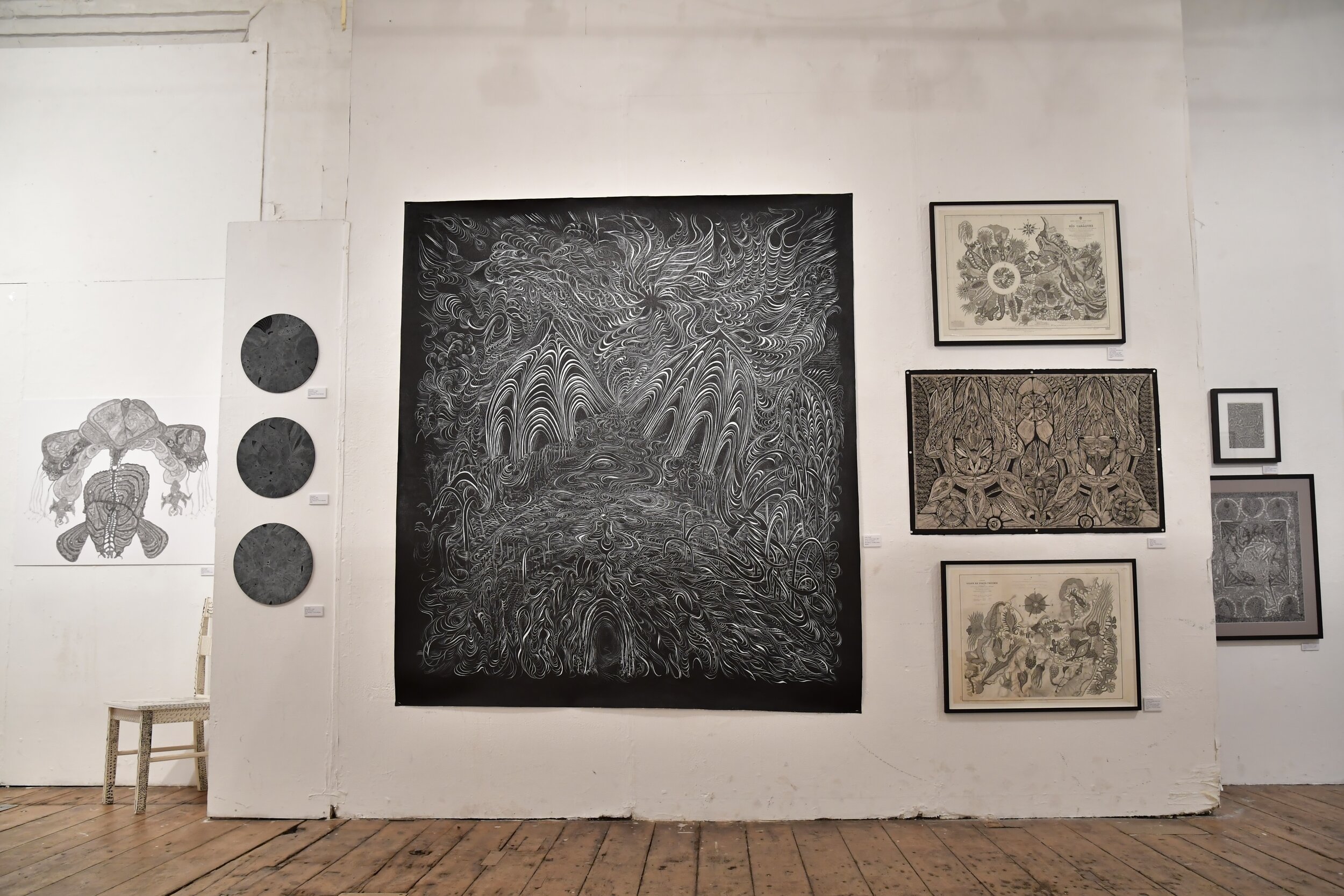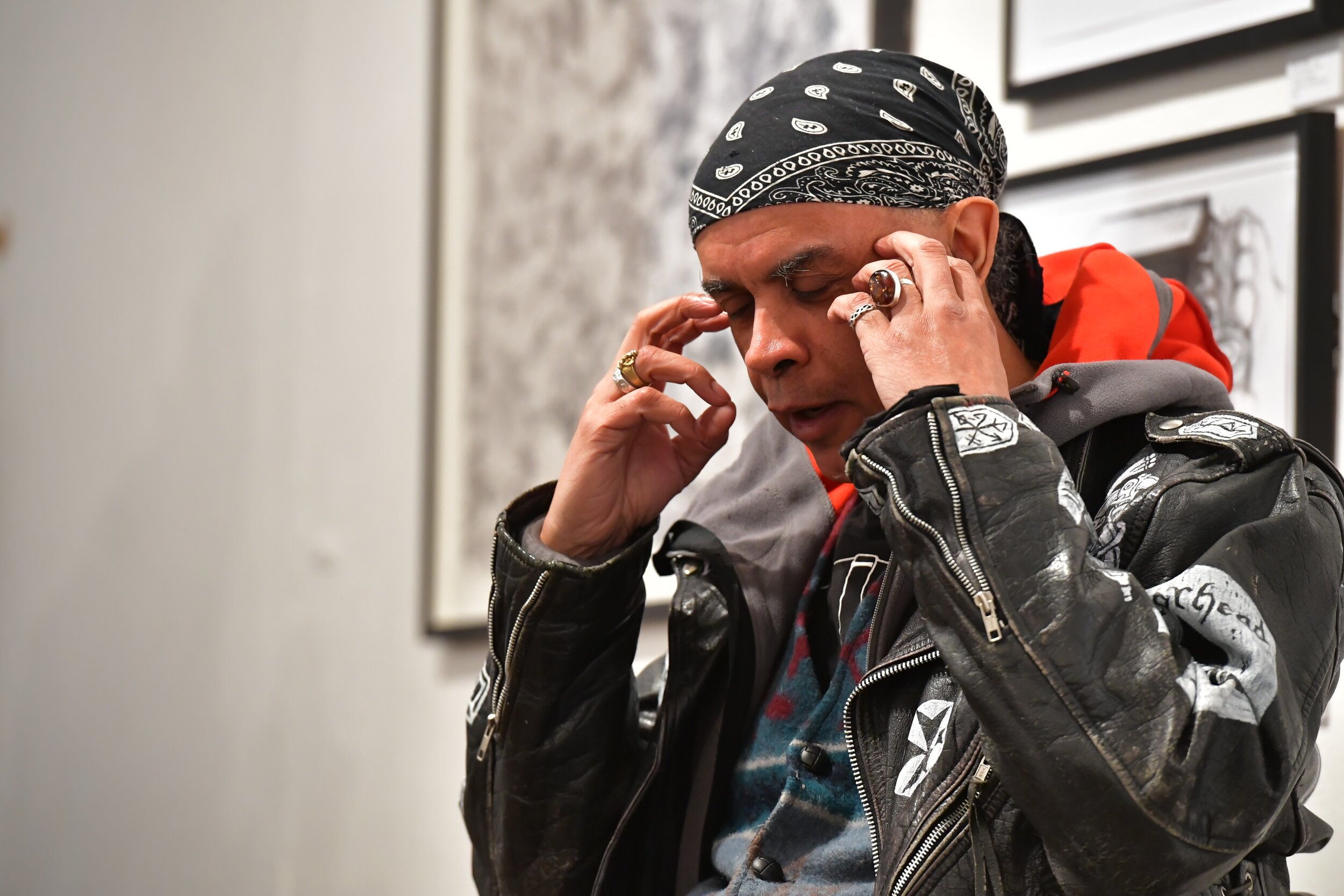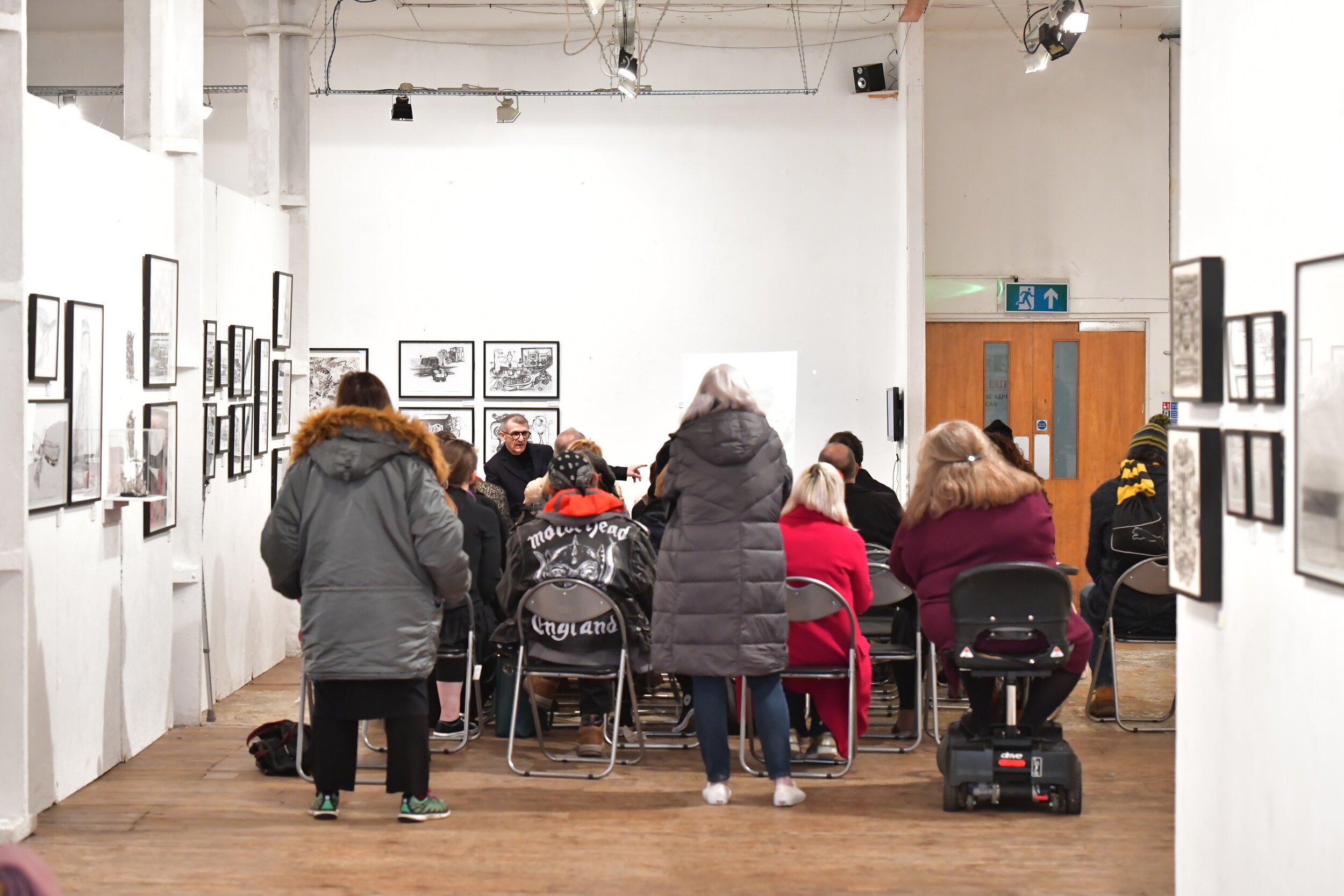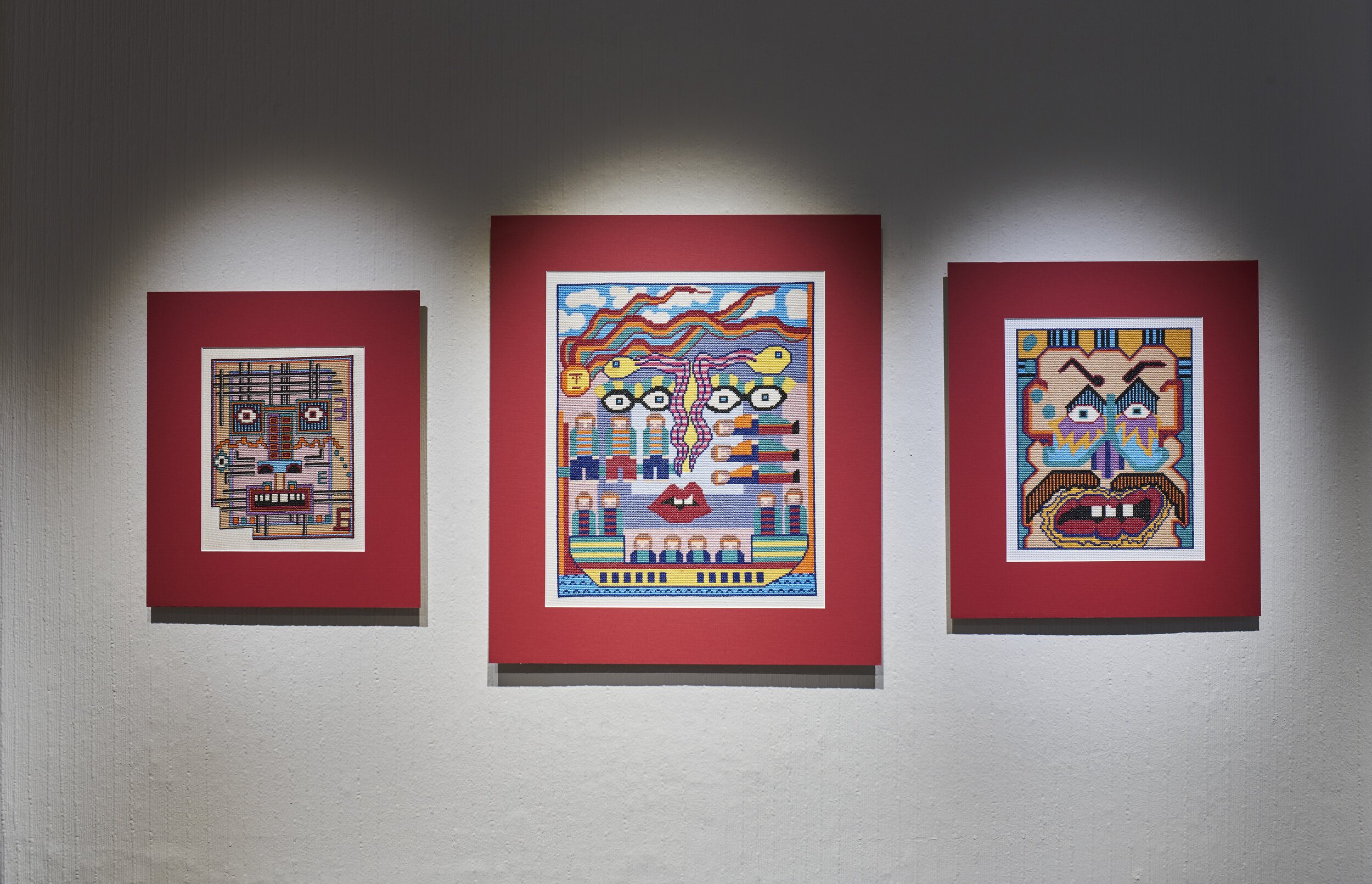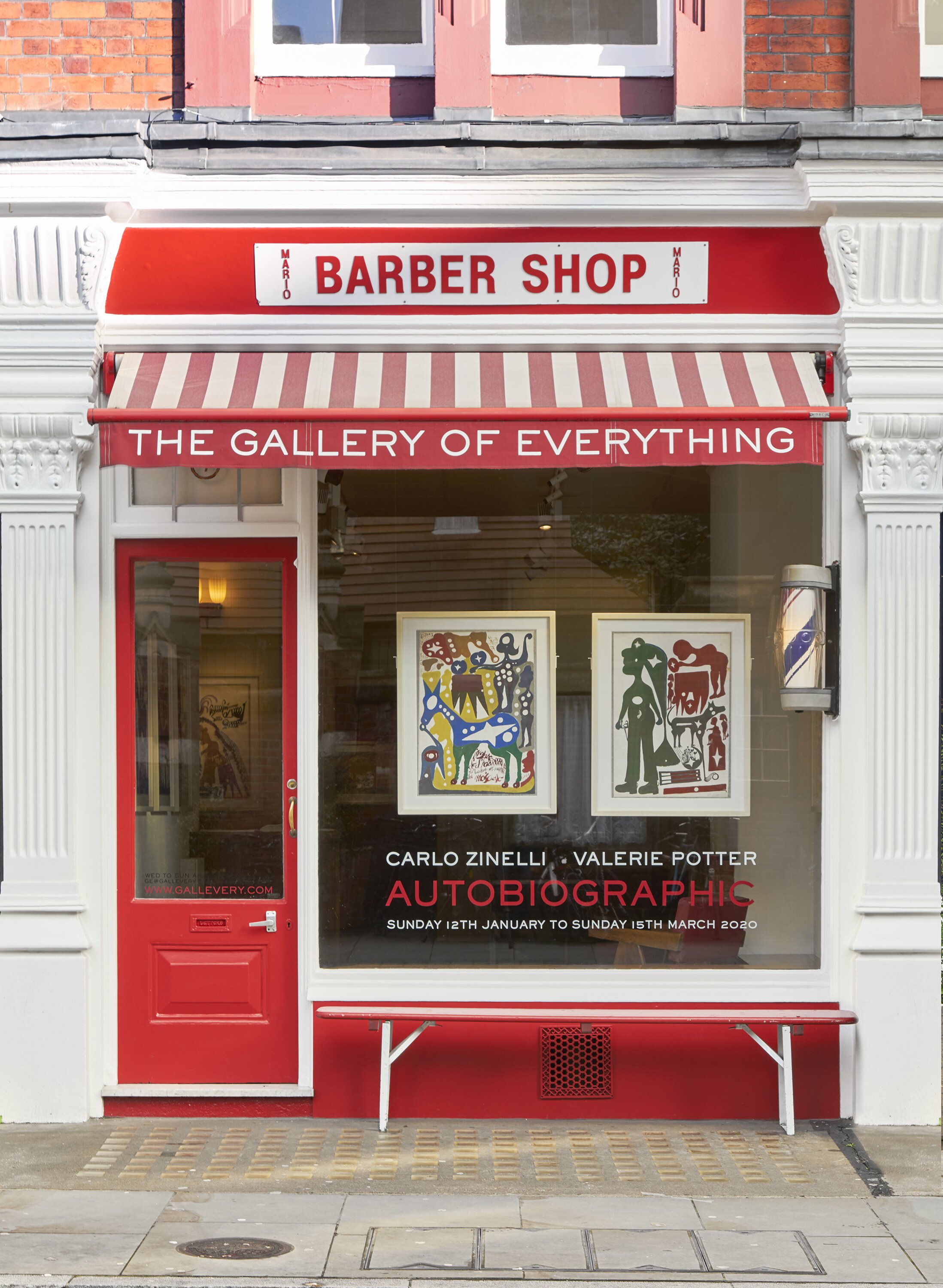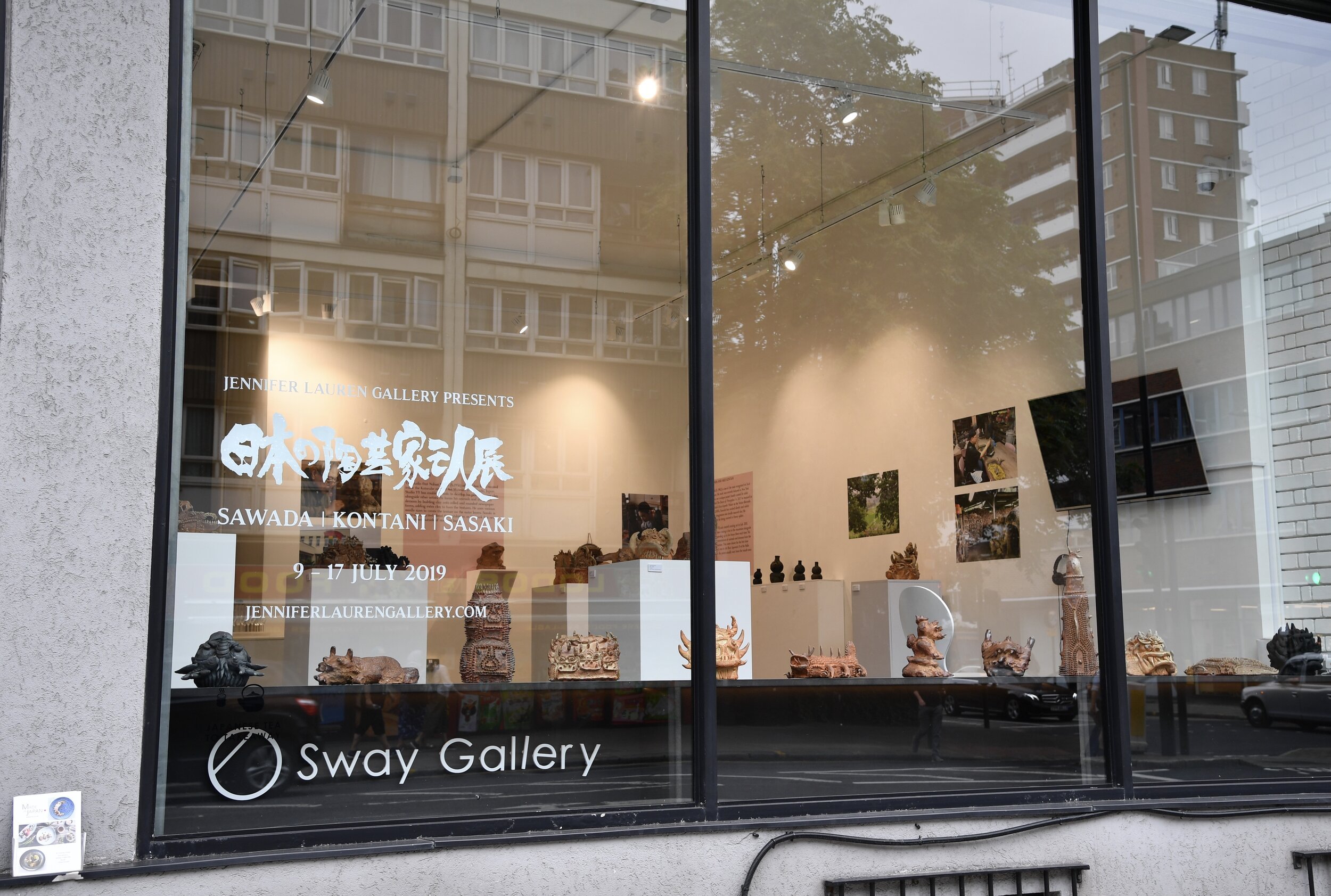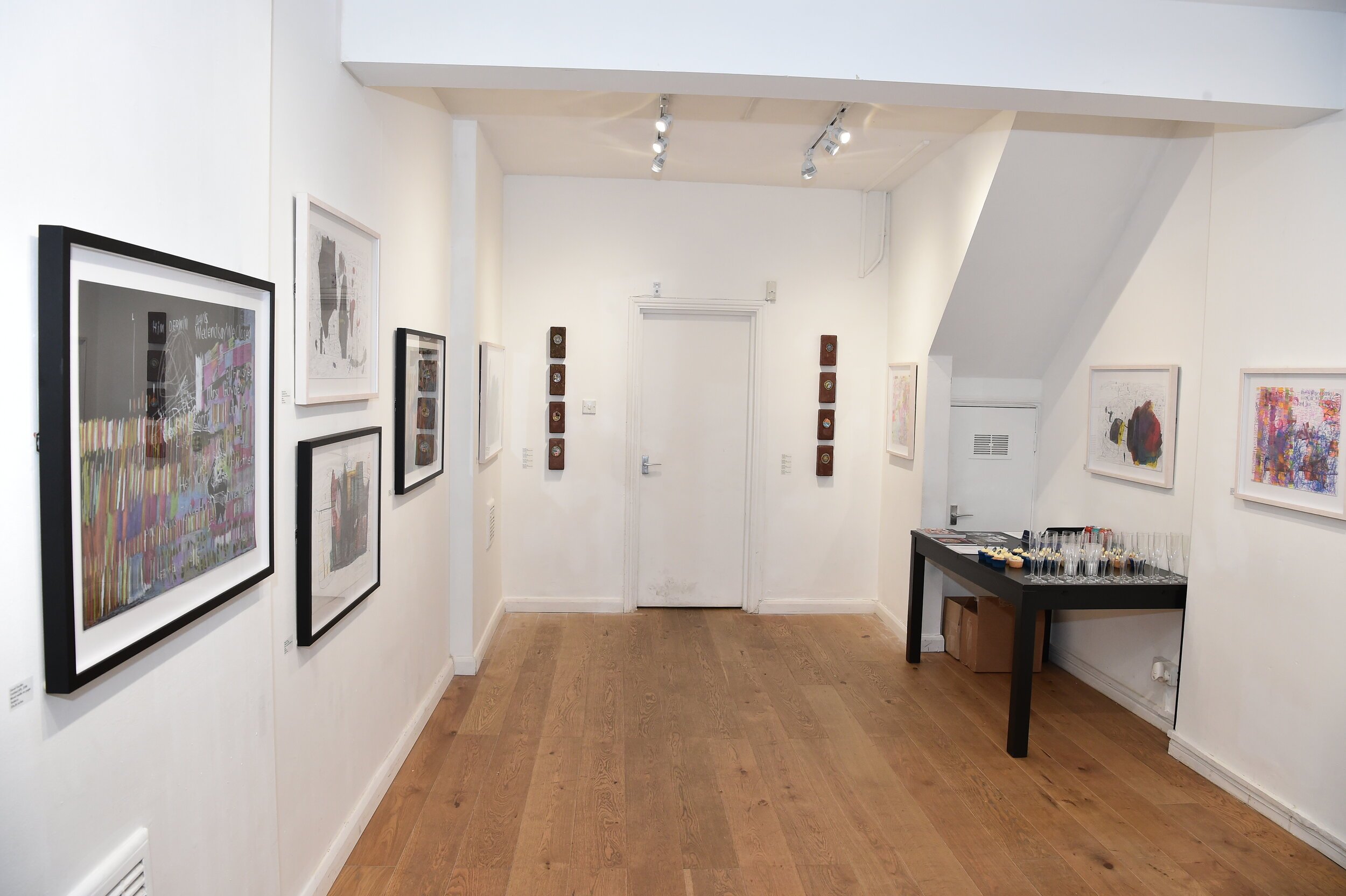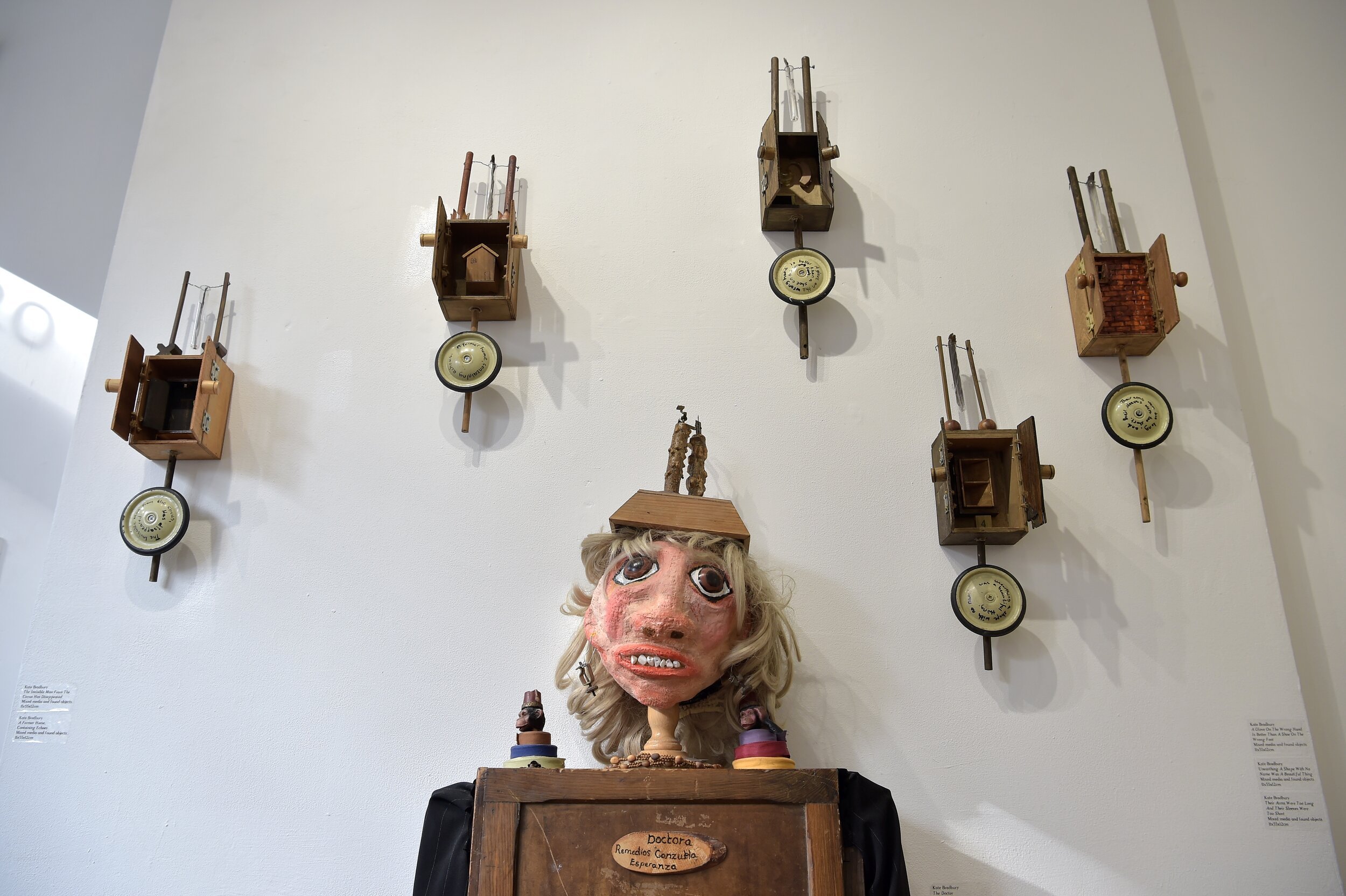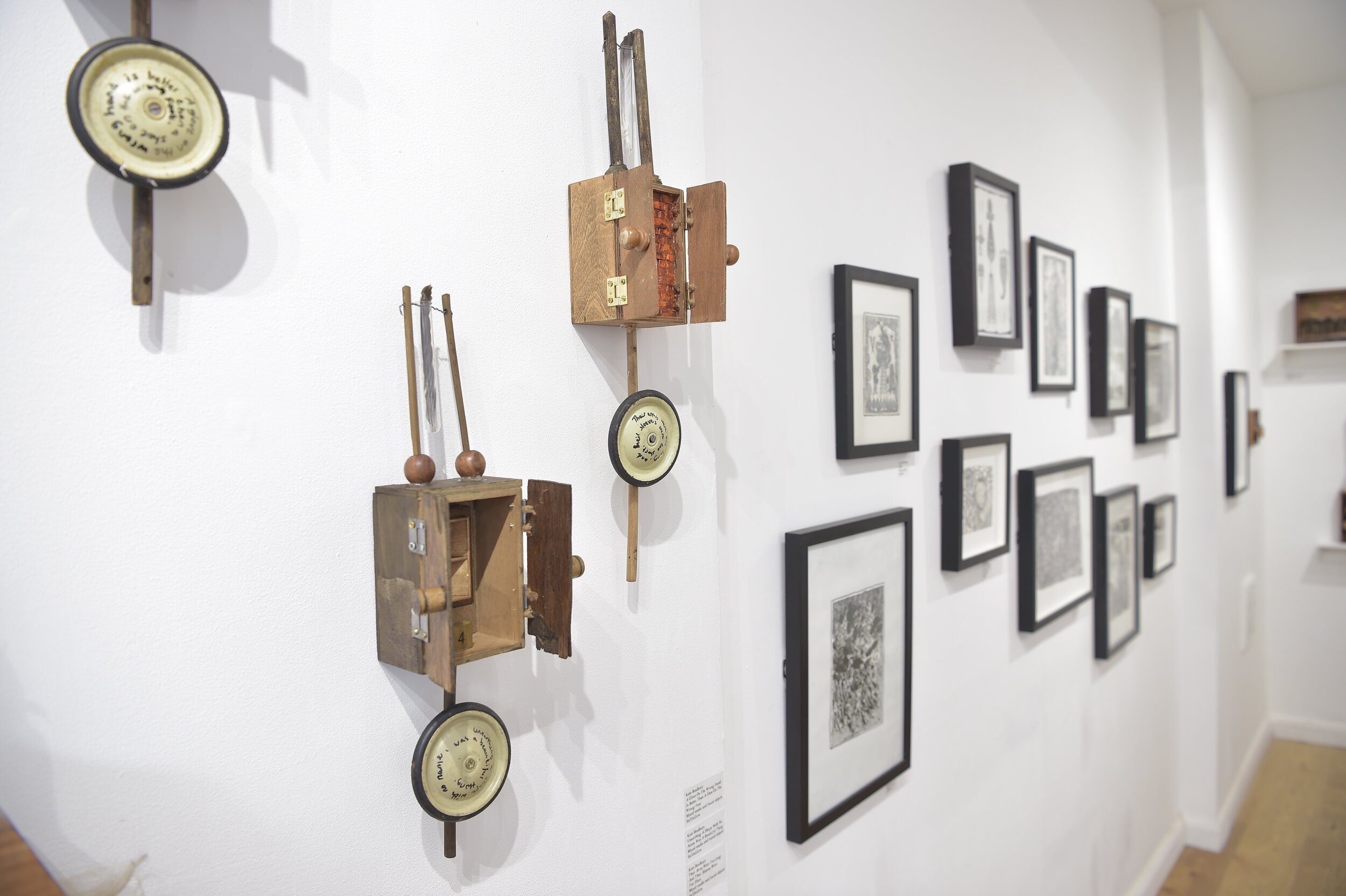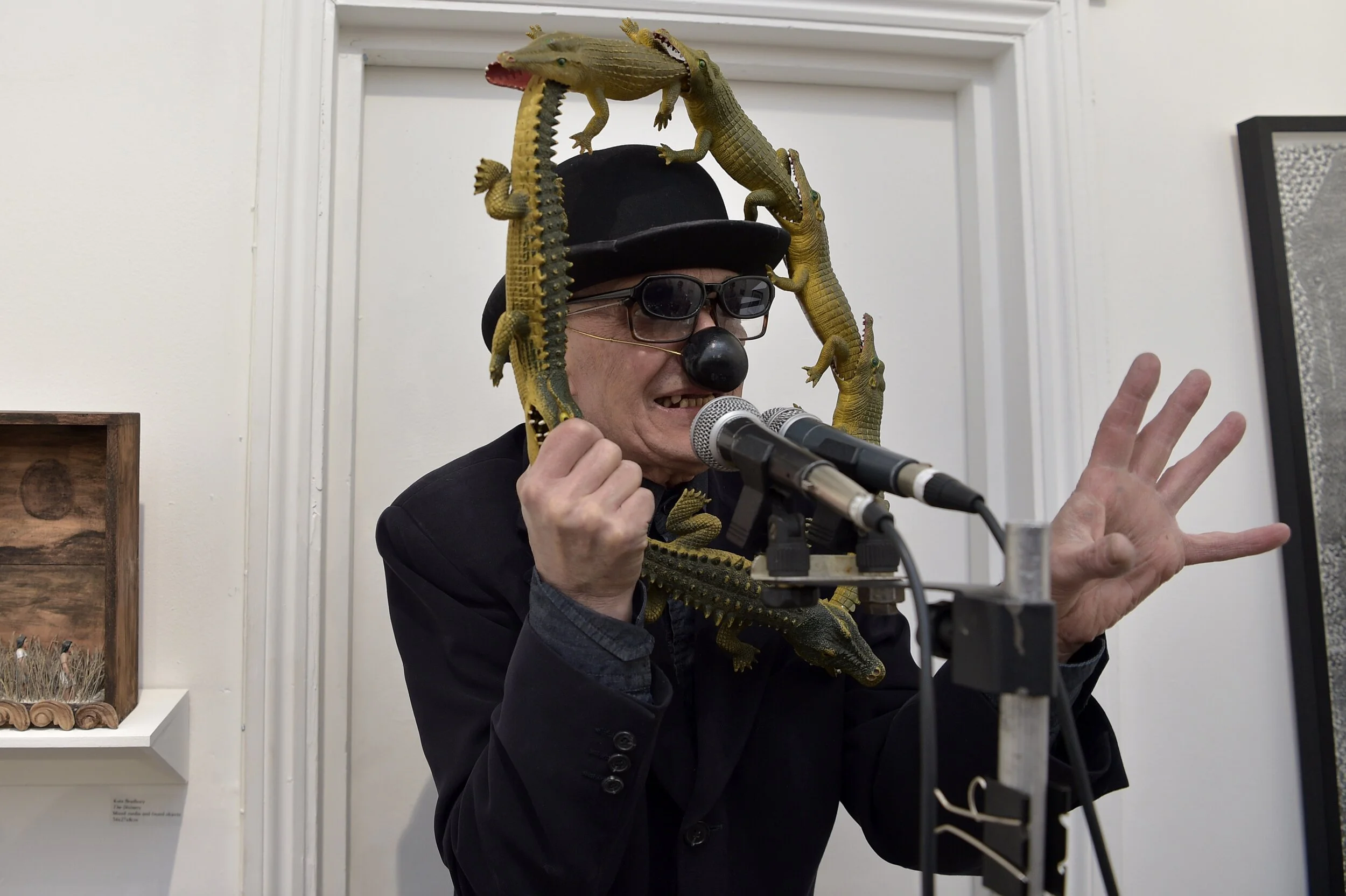
METICULOUS MARKINGS | FOUNTAIN HOUSE GALLERY
Meticulous Markings – an exhibition of eight artists at Fountain House Gallery

look here
‘Look Here’ – two exhibitions, a symposium and a book in Philadelphia from September 2025

Julia oak: through the portal and the pen
A retrospective exhibition celebrating the life and work of Julia Oak

erogenous | the box
Terence Wilde features in The Box at Pippy Houldsworth Gallery in London

SHINICHI sAWADA: AGENTS OF CLAY
‘Shinichi Sawada: Agents of Clay’ is an American touring museum show, with 30 ceramics shown spanning two decades.

SHIFT PRESENTS ‘KALEIDOSCOPIC REALMS’
A museum show in Nottingham featuring an installation of artworks and film by eight contemporary artists revealing a colourful insight into intuitive mark-marking in its many forms.

why we linger at site festival
‘Why We Linger’ at Site Festival 2024 in Stroud. An exhibition showcasing all the artists that the Gallery represents.

SHINICHI sAWADA: AGENTS OF CLAY
‘Shinichi Sawada: Agents of Clay’ is an American touring museum show, with 30 ceramics shown spanning two decades.

INSTINCTIVE ENERGIES
A joint exhibition of artwork from Cara Macwilliam and Candice Swallow entitled Instinctive Energies, invites you to share the spirit and vitality of their art.

THERE’S SOMETHING IN THERE
Jennifer Lauren Gallery presents There’s Something in There, exhibiting three artists in Paris, whose work is neither contemplated or planned and the outcome unforeseen.

WHY WE LINGER
A group exhibition showcasing all the artists that the Jennifer Lauren Gallery represents

Hilke/Jean-Michel/Makoto: Love, Hospitality & Humour
Hilke/Jean-Michel/Makoto: Love, Hospitality & Humour offers the first comprehensive look at the work of Hilke Ohlhorst (1955 - 2021). The exhibition is a collaboration between Geyso20, La "S" Grand Atelier, Vielsalm in Belgium, Atelier Corners in Japan and the Jennifer Lauren Gallery.

Shinichi Sawada solo exhibition
Presented in partnership between James Cohan Gallery and Jennifer Lauren Gallery, this will be Sawada’s second solo exhibition of ceramics in New York.

ROGER CARDINAL: CASTLES ARE ELSEWHERE
Castles are Elsewhere is an exhibition that commemorates the life of Roger Cardinal (1940-2019), whose fascination with the extraordinary led him on a wondrous odyssey upon which he encountered creativity in the most unexpected places. Roger is probably best known for his seminal book titled Outsider Art, published in 1972 - the first of its kind in the UK which this year celebrates its 50th anniversary. It was followed a few years later in 1979, with the ground-breaking Outsiders exhibition at The Hayward Gallery.

To All the Kings Who Have No Crowns
Carl Freedman presented Jennifer Lauren Gallery, showcasing seventeen international, distinct contemporary practices, revealing a diverse collection of art forms including drawing, painting, ceramics, embroidery and found object sculptures.

Prismatic Minds
An exhibition at Flowers Gallery, looking at highly stylized visual languages featuring repeated figures and characters, curated by Jennifer Gilbert and Russell Tovey.

Shinichi Sawada
About the Exhibition
Beginning February 24th, Venus Over Manhattan presented the first United States solo exhibition of Shinichi Sawada’s ceramic sculptures. The showcase of thirty works followed a recent museum solo exhibition that traveled in fall 2020 from the Museum Lothar Fischer, in Neumarkt, Germany, to the George Kolbe Museum, Berlin. On view through end of March, the Venus exhibition was organised in collaboration with Jennifer Lauren Gallery, Manchester, UK, who has worked with the artist for many years.
In conjunction with its presentation, Venus published a generously illustrated catalogue featuring new and recent writing on Sawada’s art.
Thirty-eight year old Shinichi Sawada has kept the same schedule for nearly twenty years. On Mondays, Tuesdays, and Thursdays, he attends Nakayoshi Fukushikai, a social welfare facility in Japan’s Shiga prefecture, where he spends the morning working at the in-house bakery, making bread. He spends the afternoons working with clay. Sawada first attended this facility, one of many similar institutions in Japan designed to support people with intellectual disabilities, when he was eighteen years old, shortly after he was diagnosed with autism. In the two decades since, his ceramic beasts – sometimes ghoulish, always fantastical, and deeply redolent of ancient mythologies still coursing through Japanese culture – have attracted the attention of critics and connoisseurs worldwide, notably after a presentation at the 55th Venice Biennale in 2013.
Building on both personal observations and pure imagination, Sawada continues to accrue a body of work with layers of intrigue and inventive craftsmanship.
This exhibition was reviewed in the New York Times with Jillian Steinhauer saying, “His sculptures are rich with allusions. The cartoonish, sometimes possessed looks of his creatures recall imagery from Japanese mythology and medieval bestiaries. The spikes and lines covering their bodies suggest ritual scarification. The big eyes and gaping mouths of more recent pieces echo shamanistic masks from a host of cultures. Sawada’s sculptures are made in isolation, but they gain resonance and meaning in the wider world.”
You can read it HERE.
This exhibition was also been profiled in T Magazine, through the New York Times by Courtney Coffman, which you can read HERE.
NOTE: With the virtual tour below, please click on the small arrow that says ‘play’ and it will automatically walk you around the space.

Monochromatic Minds: Lines of Revelation
About the Exhibition
The Jennifer Lauren Gallery proudly presented ‘Monochromatic Minds: Lines of Revelation’ at Candid Arts Centre in London that featured black and white work from Madge Gill, Donald Mitchell and more. Monochromatic Minds was the largest ever exhibition of disabled, self-taught and outsider artists from around the world, featuring black and white art through a variety of mediums including drawing, ceramics and textiles.
Featuring many previously unseen works from 61 artists, this exhibition brought together emerging artists alongside established outsider artists – artists who create work outside the artistic mainstream field, often by force of internal promptings and with culture not affecting their work. Several featured artists were working out of supported studios showing their work to a wider, more varied audience for the first time. This was an amazing opportunity to see unique work from international supported studios and artists isolated in the community that is rarely shown in the UK, with many of the pieces for sale.
FOR MORE INFORMATION ON THIS EXHIBITION AND THE EXHIBITING ARTISTS CLICK HERE

Autobiographic: Valerie Potter and Carlo Zinelli
About the Exhibition
The drawings and fabrics of Valerie Potter (b.1954) were unveiled after the discovery of a book by the late Roger Cardinal in a reduced book section near the artist’s home. Upon reading the seminal Outsider Art, Potter decided to send Cardinal a group of her drawings. The art historian was so impressed, he agreed to curate Potter’s first solo exhibition at the University of Kent, where he was teaching. The author subsequently introduced her material to Monika Kinley and other collectors.
Over the next thirty years, Potter embarked on a creative and autobiographical journey. Impulsive sketches and drawings evolved into delicate hand-stitched tapestries, with imagery and humorous text offering insight and advice. These instinctive explorations of the artist’s subconscious were not originally intended to be seen, let alone sold. Rather, they were a way for the artist to express an interior monologue. Yet Cardinal’s intervention and encouragement led them to occupy in an important place in the British canon of the then emerging genre known as Outsider Art.
Today Potter continues to alternate between cross-stitch works, line embroideries and elaborate colour weaves. Her work is included in a number of important collections, including the Musgrave Kinley Outsider Art Collection at the Whitworth (Manchester), The Museum of Everything (London), the Haines Collection (London) and the Moscow Museum of Outsider Art (Montenegro).
NOTE: A 360-degree view of the exhibition is available on the bottom of the exhibition page on the Gallery of Everything page that you can click on here. On that page, on the floor plan, click on the white circles on the right picture for Valerie’s work.

日本の陶芸家 三人展 Sawada | Kontani | Sasaki
About the Exhibition
The Jennifer Lauren Gallery was delighted to present a rare exhibition of the work of Shinichi Sawada, one of the most recognised art brut artists from Japan, as an official event of the Japan Season of Culture. Sawada was displayed alongside the first British showcase of Akio Kontani and Nobuo Sasaki, two fellow self-taught Japanese ceramicists, little known in this country but sharing a complementary style. All three artists’ ceramics feature bold visionary creatures and demons, alongside more recognisable animals. The exhibition was held as a pop-up at Sway Gallery on Old Street in London.
The exhibition, 日本の陶芸家 三人展, included over twenty-five highly individual works taken directly from the artist’s studios in northern and southern Japan alongside photographs of the artists at work, and the studios where they create. Often placed under the label of outsider art, this exhibition asks the audience to look at these artist’s ceramics as contemporary works, to be judged on their aesthetic quality.
At 37, Shinichi Sawada is one of the most recognised art brut artists from Japan. His work recently featured in New York at Frieze Art Fair and in 2013 he featured in Massimiliano Gioni’s Encyclopedic Palace at the Venice Biennale.
Born in 1970, Akio Kontani started creating art in 2015. Since then, he has been working alongside Shinichi Sawada, three times a week, spending up to five hours each day. His works are often representations of animals and demons from his imagination.
Nobuo Sasaki (b.1956) began living in a social welfare institution in Hokkaido from 1970 due to mental health issues. His ceramic motifs often include animals, such as gorillas, bears, birds, or imaginary demons and friends. This was Sasaki’s first exhibition outside of Japan.
On Wednesday 10 July, Mizue Kobayashi, the Art Director of social welfare organisation Aisekai in Japan, gave a talk about outsider art in Japan, its beginnings and where it is today.
Catch a virtual tour of the exhibition by Edward Enayat here
It was one of the top seven exhibitions to visit in London as suggested here
It was reviewed by CL Gamble on here blog here

Thoughts and Utterances: Threading Together the Narrative of Life
About the Exhibition
Building on its previous successes, the fourth Jennifer Lauren Gallery offering featured three artists, all sharing their memories in an explosion of colour, line and form - Ben Wilson, known as the chewing gum man, from the UK; Garrol Gayden from LAND Gallery in New York and Robert Fischer from Geyso20 in Germany. This diverse exhibition drew on the Gallery Director’s interest in text within artwork, its legibility and its purpose. Director Jennifer Gilbert said:
“Ever since my degree I have been interested in how text is used within artwork, and whether messages are subtly or openly made through this medium. These three artists use text and symbols in varying ways to either explain or narrate their ideas, or in Robert Fischer’s case we, as the audience, are left to make our own decisions on what his symbols and letters are perhaps meant to illustrate.”
Ben Wilson (b.1963) is an English wood carver creating huge wooden sculptures in his garden in London and also in Finland, Australia and the USA. However, he is better known as the chewing gum man, where, since 1998, he has created tiny works of art painted onto chewing gum that he finds on the pavement. To create the chewing gum paintings Wilson first heats the chewing gum with a small blowtorch, then coats the gum with three layers of acrylic enamel. He uses special acrylic paints, finishing each with a clear lacquer seal. No payment is taken for these.
Garrol Gayden (b.1960) creates work that focuses on New York City’s Coney Island. The Brooklyn based artist first visited Coney Island at the age of seven, and, since starting at LAND Gallery in 2005, Gayden has remained pre-occupied with this trip and his ride on the park’s ‘Spook-a-Rama.’
From the age of five, Gayden was fixated by the television and drew not only the characters from popular TV shows, but layered this with the letters and words he saw on the screen too. The use of text interwoven with figurative drawings remains the signature look of his artworks to this day. Gayden is a very talkative man, chatting about his work whilst drawing (both to himself and to others) and these phrases are often incorporated into his artworks.
In contrast Robert Fischer (b.1976) is unable to communicate about his artwork, leaving the centre and audiences to make their own judgments. Since 2004, Fischer has attended the art studio two days a week, taking several weeks and sometimes months to complete one piece.
Fischer works in a combination of pencil, crayon and felt pen. It is said that he begins his drawings with a graphic framework that reminds audiences of houses, building plans or machines. He then covers his artworks with lines, letters, and symbols, with several of the letters appearing seemingly backwards on the paper.
With thanks to Sophia Cosmadopoulos from LAND Gallery, Rachel Cohen from NAP Projects and Nina Roskamp from Geyso20 for their help in liaising with the artists for this exhibition.

From Starlings to Earth Things and All the Fish That Cannot Swim
About the Exhibition
The Jennifer Lauren Gallery presented From starlings to earth things and all the fish that cannot swim, featuring intricate black ink drawings on Chinese scroll paper and sculptures made from items found on the streets of London.
In its third show to date, the Jennifer Lauren Gallery presented the diverse work of self-taught artist Kate Bradbury (b.1961), from detailed ink scribblings on Chinese scroll paper to sculptural whirling dervishes made from found objects. With much of her work based around the objects she finds, the centrepiece of the exhibition was a new sculpture titled ‘Arkeology’, featuring a large boat and its passengers, which Kate hopes inspired others to utilise found objects in their work.
Working from her kitchen or bedroom since 2003, Bradbury is inspired by her environment, music, literature and architecture. With no formal art training, both her ink drawings and sculptural pieces evolve unexpectedly during their making as a result of much experimentation.
Of her working practice Kate Bradbury says: “I get a picture of something in my head and then need to make it, to offload it and then I can think about something else. I get obsessed with an idea and try to see it through.”
Jennifer Gilbert said: “I was first introduced to Kate Bradbury’s work in 2011 by the artist Sue Kreitzman, and have been blown away by her works ever since. This will be the third solo show of Kate’s work I have been involved with. Kate’s work never fails to make me smile and her ink drawings always amaze me when I see things in them that I didn’t see the first time.”
Vivienne Roberts, freelance Curator and previous Curator at the Julian Hartnoll Gallery said: “Kate Bradbury is part craftsman, part alchemist, and she uses her artistic genius to transform objects she finds into stunning creative forces. Her art is unique and with every new exhibition comes the excitement of seeing the unexpected and knowing that it will be a profoundly memorable experience.”
Kate Bradbury was selected as one of six Outside In award winners in 2012. She has exhibited in Pallant House Gallery, CGP London, the Julian Hartnoll Gallery and the Outsider Art Fair in Paris.

Blinko and Neate: Unlocking Worlds
About the Exhibition
Following on from the successful launch exhibition Masao Obata: Drawing Happiness in Red, the Jennifer Lauren Gallery presented their second exhibition Blinko and Neate: Unlocking Worlds. Teaming up with London based Henry Boxer Gallery; this exhibition showcased the intricate monochromatic drawings of Nick Blinko and Chris Neate.
Taking their inspirations from different sources, both artists share a highly detailed aesthetic and intensive, sometimes obsessive working process. Blinko represents his thoughts about his illness and the effects of his medication whereas Neate allows his hands to produce automatic creations dependent upon his frame of mind.
Part artist, part lead singer of the heavy punk band Rudimentary Peni, Blinko has a cult following who appreciate him on both levels. His drawings depict fantastically intricate confrontations with his own demons yet not all the faces in his work are malignant: among the skulls and fractured dolls, there are ironic faces and mischievous things. Blinko said: “My initial intention was to try to depict melancholy … I got frustrated at the attempts to depict suicidal depression realistically, and I got more and more into detail.”
Chris Neate attended Art College in Leeds in the 1970’s but never completed a foundation course nor did he feel he was given any formal training. He became involved in the avant-garde music scene and illustrated the record covers for emerging bands including Softcell’s ‘Tainted Love’.
During his time working as a hospital social worker with older people he drew sporadically. His need to draw intensified over the years. Neate said: “I think that I get some degree of comfort from drawing and if I do it intensely then I can get into quite a meditative state and lose myself in the process.”
Jennifer Gilbert said: “Both artists portray a fantastical attention to detail with microscopic precision, with messages in their works that may or may not be obvious to us. By placing them side-by-side I wanted to show how two artists that are compelled to draw, for varying reasons, produce complex works that fascinate the viewer and lead us to reach for a magnifying glass.”
With thanks to Tony Thorne, Consultant at Kings College London, and Vivienne Roberts, Curator at the College of Psychic Studies London, for allowing me to use parts of their texts on each artist to write this.

Masao Obata: Drawing Happiness in Red
About the Exhibition
Jennifer Lauren Gallery was delighted to present its first show and the first solo show for the late Masao Obata. After featuring in the successful Souzou: Outsider Art from Japan at the Wellcome Collection in 2013, Obata’s work has rarely been seen in Japan or overseas. This exhibition brought together a collection of 15 works, which were seen alongside a film from 21-25 June 2017 in London.
Obata (b. 1943) moved around many institutions before settling at Hyogo Prefecture where he began to draw in his 60’s. His strong urge to create led him to source large cardboard pieces to draw on from the kitchens in his facility as he felt the paper was too flimsy. He produced thousands of drawings before his passing in 2010, but many were disposed of by the facility who, in the beginning, had not recognised the artistic value of his work.
Obata said, “I am happiest when I am working and by working, I mean drawing.” Claiming he was shy, Obata rarely left the institution, not even venturing into the grounds.
Often creating in red pencil, Obata stated that for him this was the colour of happiness and fulfilment. The major themes in Obata’s work include family and marriage, both of which eluded Obata during his lifetime. He did on occasion say that the works featuring a man, a woman and a child were himself and his parents, and that he missed them profusely. His drawings also featured a characteristic attention to detail when depicting genitalia in his representations of humans. Other themes included things he observed: vehicles, landscapes and plants.
Masao Obata’s work has been seen in several international exhibitions including in Switzerland, Paris and the Netherlands.
Jennifer Gilbert said: “After seeing Obata’s work behind the scenes before being featured in the Japon exhibition at the Collection de l’Art Brut in Lausanne in 2008, I have been interested in this artists work. Seeing him working in a film during the Wellcome Collection exhibition in 2013 further cemented my enjoyment of his work, especially his fascination with drawing and dressing head-to-toe in red, and the fact he often fell asleep whilst drawing.”









